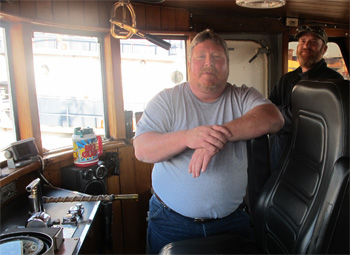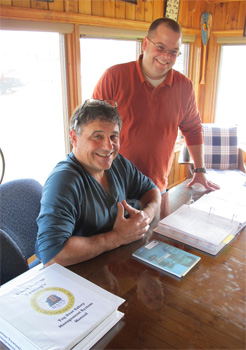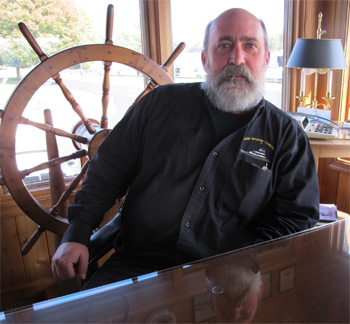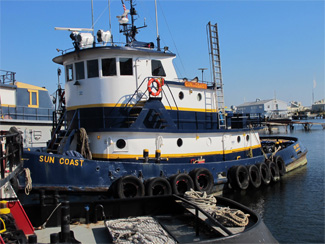John Rutledge is the captain of Sun Coast, an 85-foot, 1,800-hp Dann Marine Towing tug that operates in the Baltimore area. A hawsepiper, the captain has seen a multitude of changes in his long career, but few as significant as the coming of vessel safety management systems.
The towing industry, he observed, “is still a dangerous business. People get hurt real easily. We try to manage the risks and the dangers.”
Dann Marine’s new vessel safety management system (VSMS) helps him manage those risks by identifying any potential problems on his boat and by helping his crew gain a heightened sense of how to operate safely.
 |
|
Capt. John Rutledge, Sun Coast’s master in the pilothouse. John Mehaffey, the tug’s relief captain, stands behind him. Rutledge thinks the VSMS helps him and the crew to operate safely. |
“We’re always trying to go for zero incidents. I think it’s helped us to achieve that,” he said of the company’s new management safety system.
Built in 1965, Sun Coast is approaching 50 years of age. Far from retirement, it moves barges around the port of Baltimore, primarily serving a power plant by delivering coal for fuel and limestone for the scrubbers that remove pollutants from its stacks. Typically it is paired with a 360-foot barge that can carry 8,000 tons of coal. Occasionally the tug makes the 300-mile round trip down the Chesapeake Bay to Norfolk, Va., and back.
“An older vessel like this couldn’t pass (inspections) unless the company stayed on it diligently,” Rutledge said.
When he made that observation, he was sitting in the mess area of Sun Coast as it sat at a pier at the Smith Shipyard in Baltimore undergoing a two-month rehabilitation that included rebuilding both generators, replacing handrails, repairing bulwarks and the push knees, and installing a new hawser, watertight doors, radar and a fire detection system.
At its heart, a VSMS helps a company identify any physical problems on a boat that might compromise safety and then document the steps taken to correct the problems. It also addresses the human element by documenting crew responsibilities and procedures in place to ensure safe operations.
Of late vessel safety management systems have taken center stage in the towing industry because of the U.S. Coast Guard’s proposed Subchapter M requirements. Under the new rules, most towing vessels would have to meet mandatory inspection requirements. Towing companies would have to pass an annual inspection by the Coast Guard. Alternatively, an operator could create a towing safety management system (TSMS), have it audited by an outside third party such as a classification society and then submit it to the Coast Guard for acceptance. So far the Coast Guard has not decided when it will issue a final rule that would bring the Subchapter M requirements into force.
Rutledge described the pending inspection requirements as “the biggest change the industry has ever seen. If that doesn’t shake them to the core, nothing will.”
Despite the uncertainly about when the new regulations will take effect, Dann Marine Towing’s management decided it wanted to be ahead of the game by developing a VSMS that would be in place when the new rules are adopted. Aside from regulatory compliance, the company sees the safety management program as valuable in and of itself. First, it reinforces the company’s longstanding commitment to safety. And being able to demonstrate that commitment may give Dann Marine a competitive advantage when approaching customers concerned about the safe movement of their cargo.
 |
|
Christian LaPense (seated), Dann Marine’s compliance manager, and Jason Wisneski (standing), the company’s safety manager, developed a safety management system that meets ISM Code standards. The safety manual serves as a central element in crew training. |
Dann Marine has long been a participant in the American Waterways Operators’ (AWO) Responsible Carrier Program (RCP). Using the RCP as a starting point, Dann Marine decided to develop a safety system that would meet the standards of the International Safety Management (ISM) Code, which the Coast Guard proposes to accept as equivalent to the TSMS requirements.
“We’ve always been safe, even before RCP,” said Robert Dann, an owner of the company who serves as port engineer at the company’s headquarters in Chesapeake City, Md., on the banks of the Chesapeake & Delaware Canal. “RCP and ISM are putting us in the forefront and ahead of the competition.”
Dann Marine put two experienced mariners in charge of the development of the VSMS. Jason Wisneski, the company’s safety manager, maintains a third mate’s unlimited license and worked as a first mate on passenger casino vessels on the Great Lakes. Christian LaPense, the compliance manager, spent 20 years in the Coast Guard, 14 of them as an engineer aboard vessels.
Beginning in February 2011, the two began doing research to determine what needed to be added to the RCP standards to bring them up to the ISM Code. Once they had devised a program that they thought would meet ISM standards, they contacted the American Bureau of Shipping (ABS) to determine if they could be certified as ISM compliant.
By the end of September 2012, Dann Marine had received authority from ABS to begin using its new ISM-based manual. Six months later, ABS conducted the first audit of the system. The ABS consultant concluded that the company needed to further document some of its practices. Once that was done, the process was complete.
“On 13 June 2013, we became fully certified as ISM compliant,” LaPense said.
Dann Marine’s fleet consists of 18 tugs and 20 barges. It has always had procedures for inspecting its vessels, so the new system did not fundamentally change its maintenance and repair procedures, but it did create a much more rigorous system for documenting everything that is done. In the past, LaPense said, some things would just be taken care of informally, perhaps with just a phone call. Now there is a paper trail for all the issues identified and the work done to resolve them.
In one sense, not much has changed as a result of the creation of the VSMS and the manual that defines it. The company’s inspections of its vessels are not more frequent or rigorous, according to LaPense. And the operation procedures are much as they were.
In another sense, the changes are profound. From a regulatory perspective, Dann Marine can now prove to outside parties the rigor of its maintenance and repair programs, and its operating procedures. And internally it has a document that it can use as a teaching tool to drive home to its crews the central importance of safe operations.
“The ultimate goal is to get (the crew) to read this manual, to make it a part of their lives,” LaPense said.
Essentially, the VSMS manual has become the textbook for each employee’s continuing safety training.
There are at least four safety drills per month. An additional safety drill or safety meeting on a topic selected by the head office is performed weekly. The captain leads the onboard safety meetings, often in the mess area during lunch. The captain has wide discretion on how to conduct the meetings. In each case — whether drill or safety meeting — the topic corresponds to a section of the VSMS manual.
For example, in April the first safety meeting was to cover Vessel Safety Orientation. Chapter 5 of the manual has a section that discusses that topic. One drill for the month was Man Overboard. Those procedures are described in Chapter 6. With each drill and safety meeting, the crews are reminded of what the manual has to say on the subject.
 |
|
Robert Dann, port engineer at Dann Marine’s base in Chesapeake City, Md., says the new VSMS reinforces the company’s longstanding commitment to operating safely, while demonstrating to customers that the company’s vessels meet stringent safety operating standards. |
Each week, the captain has an explicit duty to remind his crew of its contents. “They are forced to open the book and involve the crew,” Wisneski said.
Each vessel gets an inspection visit from either Wisneski or LaPense once every three months. “We expect this book to be dirty when we get aboard. They should have fingerprints on them,” LaPense said. If they don’t, “That’s an alarm.”
While the company expects crews to abide by the manual, it also wants them to understand that this is a living document that will be constantly revised to reflect new information.
Dann observed, “If an item is brought up by a customer, we change it, not just on that one (vessel); we change it companywide.”
Information from inside the company can lead to changes as well. Suggestions from crews, lessons learned from an injury or near collision — any and all sources are considered.
“This isn’t a set-in-stone book,” Wisneski said.
While Dann Marine chose the ISM model, other safety-conscious companies are taking different routes to raising safety standards for their vessels and crews.
Canal Barge Co., for example, meets the standards of the AWO’s Responsible Carrier Program. The AWO is working with the Coast Guard so that its program will become a Coast Guard-accepted towing safety management system by the time the Subchapter M requirements take effect. That would give the AWO program the same status as an ISM system.
“The foundation of our safety management system continues to be RCP,” said Joe Tyson, the New Orleans-based company’s supervisor of operations.
For Canal Barge, however, meeting the standards of RCP is just the beginning. The leadership of the company is thinking not just in terms of meeting the minimum regulatory requirements, but in achieving the highest safety operating standards possible.
“Our goal is to be best in class,” said Tom Smith, the company’s vice president of quality and customer service.
Canal Barge operates a fleet of 35 towboats and more than 800 barges. Much of its business involves the transport of petroleum products. Its approach to safety management has been greatly influenced by practices developed in the petroleum industry. Notable among them is a program called Tanker Management Self-Assessment (TMSA).
The oil industry devised the system to help vessel operators transporting their products meet higher safety standards. TMSA employs a process of continual improvement to prevent injury to people (both employees and the public), the environment and equipment. Tyson said that Canal Barge has been using TMSA since 2008 as a way to improve its management system effectiveness and operations.
Under TMSA, Canal Barge assesses specific aspects of its operations, including safety of mariners, navigation safety, environmental stewardship, preventive maintenance and risk assessment.
The idea, Smith said, is to keep getting better rather than simply meet a set of standards or regulations.
In the course of this effort, the company is constantly reshaping existing procedures and creating new ones to manage and reduce risk.
“This will help us go way beyond compliance,” Smith said.
The involvement of the crews has been a key element in the success of this approach. “This engagement is very crucial to the success of any safety management system,” Smith said. “We do have good support from our mariners.”
Refining and improving procedures and then implementing them with the assistance of employees aboard vessels and ashore is not easy, Smith said. “Without a doubt, this has been hard work,” he said. “Over time it is very rewarding.”
“We are making significant progress, with the environment, with people and with the equipment,” Tyson said.
Over the last eight years, according to Tyson, equipment has become more reliable and the number of spills has been reduced. Vessel crews have been involved in fewer collisions and groundings. And the severity of those incidents has also declined.
“Continuous improvement is the mission,” he said.
Not every towing company immediately understood the value of VSMS. Jennifer Carpenter, the AWO’s executive vice president, notes that the RCP has been in place for two decades and the ISM Code for a bit more than that. Some AWO members, she said, were initially skeptical about the costs and benefits of the RCP. “We’ve had members who were very concerned when we went down the RCP road.” But once enrolled, their views changed as safety levels improved and costs, such as insurance, fell. She says she has been told by AWO members that participating in the RCP was “the best thing that ever happened to the company.”
Over that time there has been a growing recognition among vessel operators, their customers and insurers that these safety management system programs do indeed make the industry safer and can save money.
“These things work,” she said.

